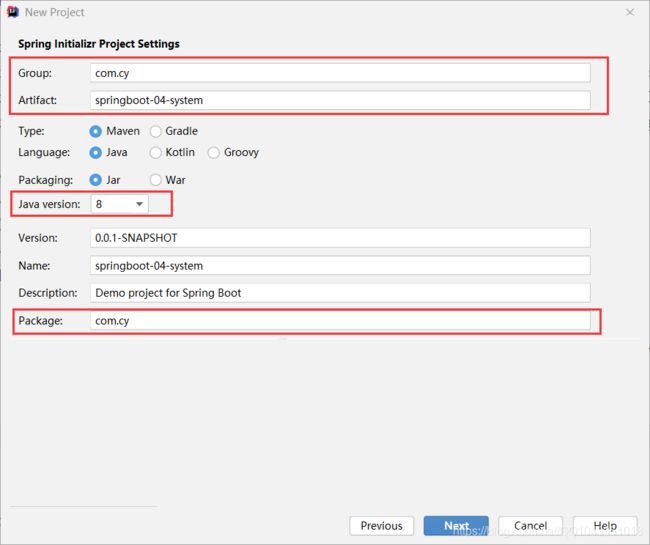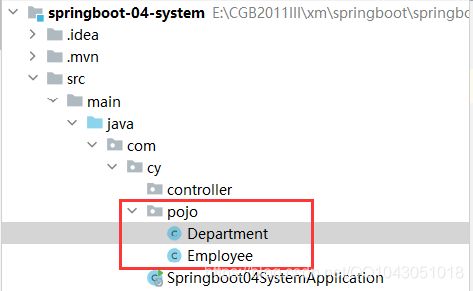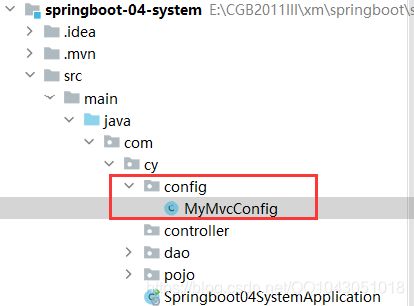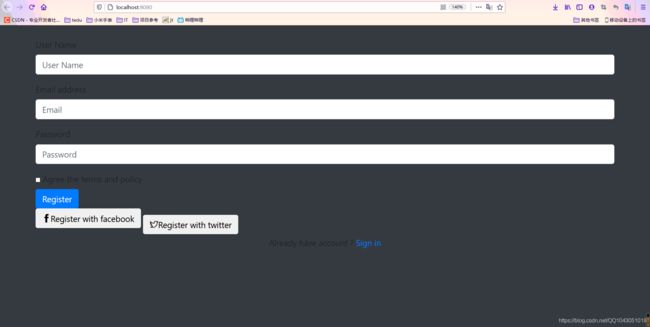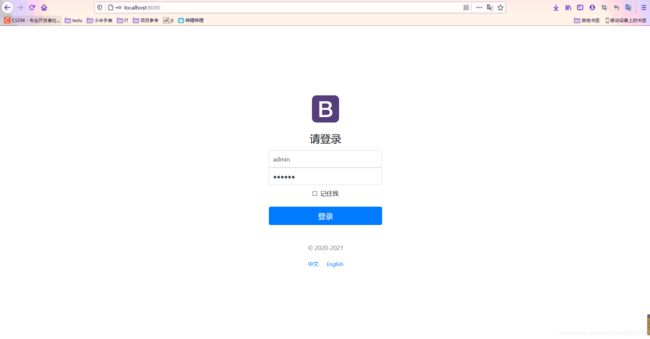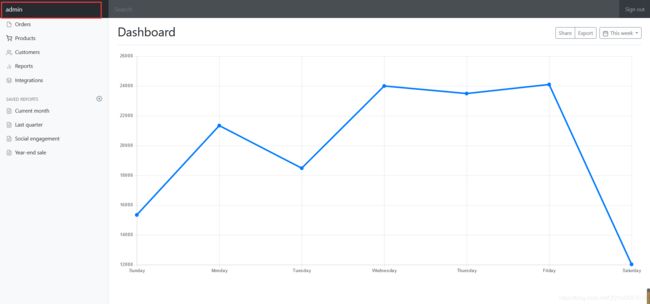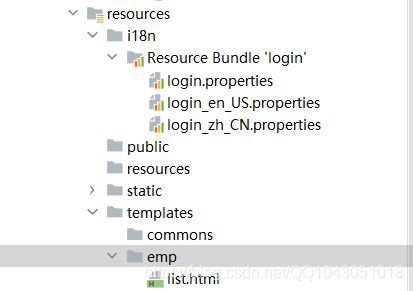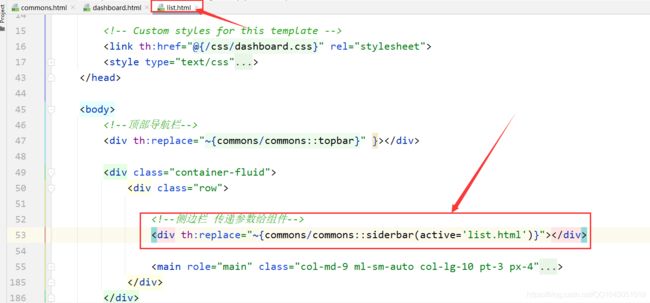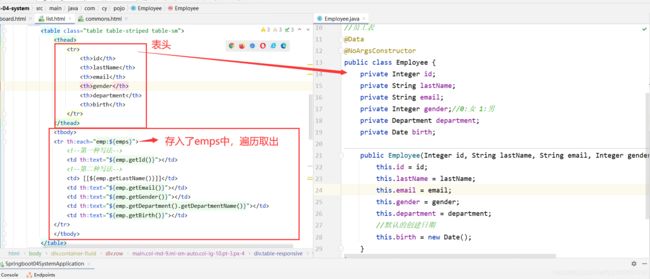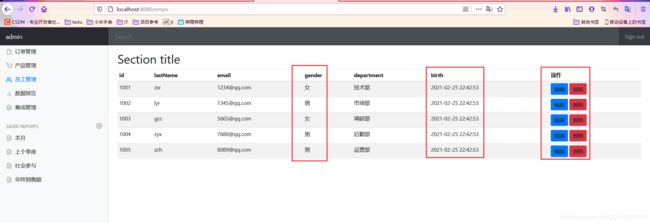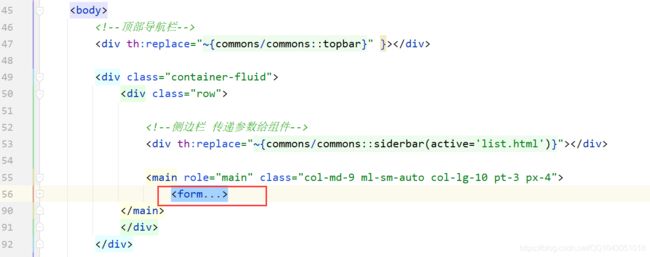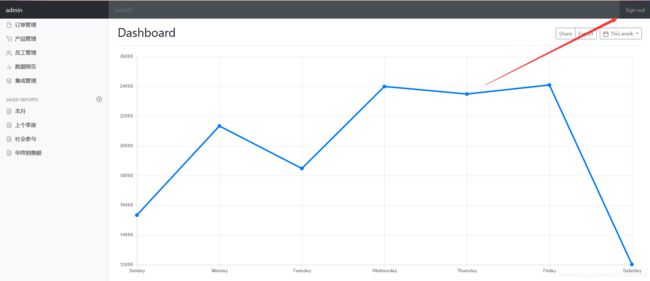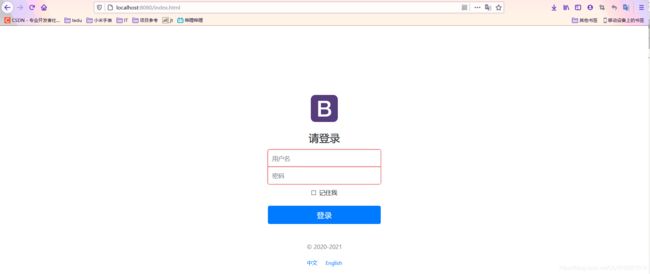JAVA SpringBoot-09 狂神 员工管理系统
员工管理系统
后台模板下载地址:https://sc.chinaz.com/tag_moban/houtai.html
项目所需的资源搜索公众号:淡若清风丶

后台回复静态资源获取: 员工管理系统
一、环境搭建
1.新建一个SpringBoot项目
选择依赖时勾选 SpringWeb 和 Thymeleaf、Lombok
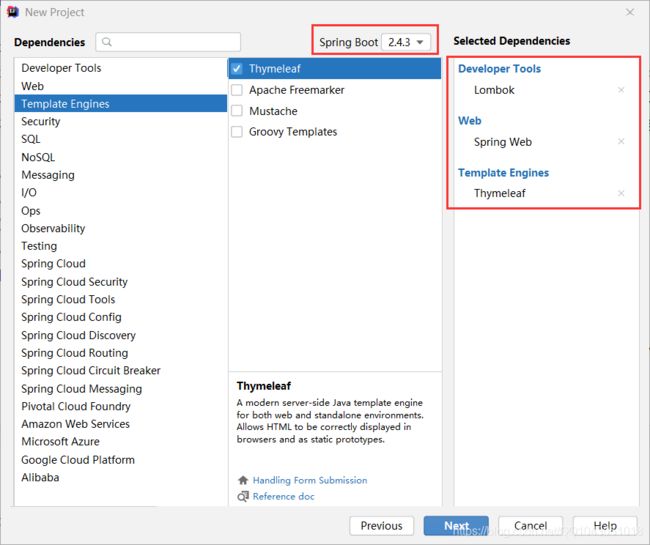
点击next,然后finish创建完成即可

选择This Window然后等待资源下载完成即可
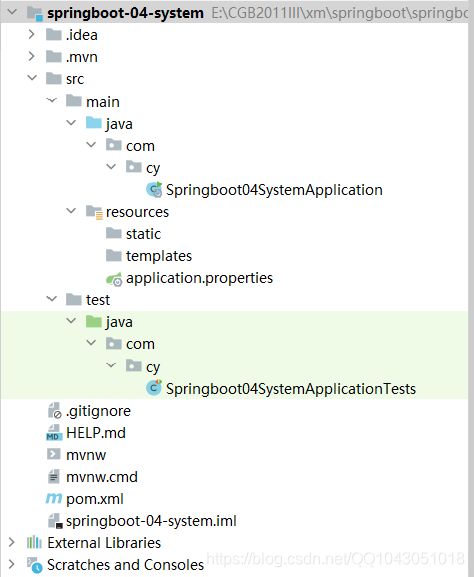
2. 导入静态资源(也可以选择数据库)
3. 模拟数据库
1.创建数据库实体类
-
在主程序同级目录下新建pojo包,用来存放实体类
-
在pojo包下创建一个部门表Department和一个员工表Employee
部门表
package com.cy.pojo;
import lombok.AllArgsConstructor;
import lombok.Data;
import lombok.NoArgsConstructor;
//部门表
@Data
@NoArgsConstructor
@AllArgsConstructor
public class Department {
private Integer id;
private String departmentName;
}
员工表
package com.cy.pojo;
import lombok.Data;
import lombok.NoArgsConstructor;
import java.util.Date;
//员工表
@Data
@NoArgsConstructor
public class Employee {
private Integer id;
private String lastName;
private String email;
private Integer gender;//0:女 1:男
private Department department;
private Date birth;
public Employee(Integer id, String lastName, String email, Integer gender, Department department) {
this.id = id;
this.lastName = lastName;
this.email = email;
this.gender = gender;
this.department = department;
//默认的创建日期
this.birth = new Date();
}
}
2.编写dao层(模拟数据)
在主程序同级目录下新建dao包
然后分别编写DepartmentDao 和 EmployeeDao,并在其中模拟数据库的数据
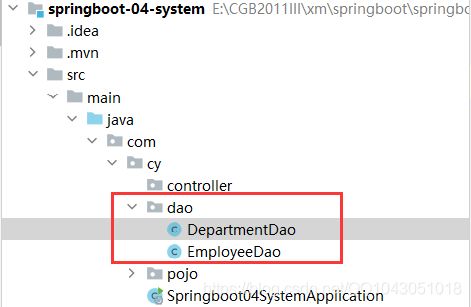
DepartmentDao:
package com.cy.dao;
import com.cy.pojo.Department;
import org.springframework.stereotype.Repository;
import java.util.Collection;
import java.util.HashMap;
import java.util.Map;
//注册到IOC容器中
@Repository
public class DepartmentDao {
//模拟数据库中的数据
private static Map<Integer, Department> departments = null;
static {
departments = new HashMap<>();//创建一个部门表
departments.put(1001, new Department(1001, "技术部"));
departments.put(1002, new Department(1002, "市场部"));
departments.put(1003, new Department(1003, "调研部"));
departments.put(1004, new Department(1004, "后勤部"));
departments.put(1005, new Department(1005, "运营部"));
}
//获得部门的所有信息
public Collection<Department> getDepartments() {
return departments.values();
}
//通过id得到部门
public Department getDepartmentById(int id) {
return departments.get(id);
}
}
EmployeeDao:
package com.cy.dao;
import com.cy.pojo.Department;
import com.cy.pojo.Employee;
import org.springframework.beans.factory.annotation.Autowired;
import org.springframework.stereotype.Repository;
import java.util.Collection;
import java.util.Date;
import java.util.HashMap;
import java.util.Map;
//注册到IOC容器中
@Repository
public class EmployeeDao {
//模拟数据库中员工表的数据
static private Map<Integer, Employee> employees;
//员工所属的部门
@Autowired//自动注入
private DepartmentDao departmentDao;
static {
employees = new HashMap<>();//创建一个员工表
employees.put(1001, new Employee(1001, "zsr", "[email protected]", 0, new Department(1001, "技术部")));
employees.put(1002, new Employee(1002, "lyr", "[email protected]", 1, new Department(1002, "市场部")));
employees.put(1003, new Employee(1003, "gcc", "[email protected]", 0, new Department(1003, "调研部")));
employees.put(1004, new Employee(1004, "zyx", "[email protected]", 1, new Department(1004, "后勤部")));
employees.put(1005, new Employee(1005, "zch", "[email protected]", 1, new Department(1005, "运营部")));
}
//主键自增
private static Integer initialID = 1006;
//增加一个员工
public void addsave(Employee employee) {
if (employee.getId() == null)
employee.setId(initialID);
//部门关联外键
employee.setDepartment(departmentDao.getDepartmentById(employee.getDepartment().getId()));
employees.put(employee.getId(), employee);
}
//查询全部员工信息
public Collection<Employee> getAll() {
return employees.values();
}
//通过id查询员工
public Employee getEmployeeByID(Integer id) {
return employees.get(id);
}
//通过id删除员工
public void deleteEmployeeByID(int id) {
employees.remove(id);
}
}
二、首页实现
- 在主程序同级目录下新建config包用来存放自己的配置类
1.设置视图跳转
package com.cy.config;
import org.springframework.context.annotation.Configuration;
import org.springframework.web.servlet.config.annotation.ViewControllerRegistry;
import org.springframework.web.servlet.config.annotation.WebMvcConfigurer;
@Configuration
public class MyMvcConfig implements WebMvcConfigurer {
@Override
public void addViewControllers(ViewControllerRegistry registry) {
registry.addViewController("/").setViewName("index");
registry.addViewController("/index.html").setViewName("index");
}
}
我们启动主程序访问测试一下,访问localhost:8080/或者locahost:8080/index.html
上述测试可以看到页面有图片没有加载出来,且没有css和js的样式,这就是因为我们html页面中静态资源引入的语法出了问题,在SpringBoot中,推荐使用Thymeleaf作为模板引擎,我们将其中的语法改为Thymeleaf,所有页面的静态资源都需要使用其接管!
2.引用Thymeleaf模板引擎
【注意】所有html都需要引入Thymeleaf命名空间
xmlns:th="http://www.thymeleaf.org"
然后修改所有页面静态资源的引入,使用@{...} 链接表达式
例如index.html中:
注意:第一个/代表项目的classpath,也就是这里的resources目录
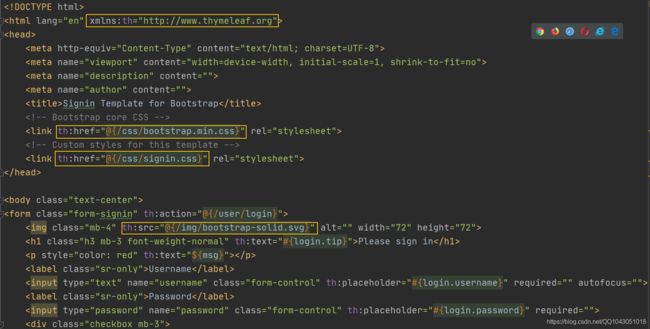
<html lang="en" xmlns:th="http://www.thymeleaf.org">
<head>
<meta http-equiv="Content-Type" content="text/html; charset=UTF-8">
<meta name="viewport" content="width=device-width, initial-scale=1, shrink-to-fit=no">
<meta name="description" content="">
<meta name="author" content="">
<title>登录首页title>
<link th:href="@{/css/bootstrap.min.css}" rel="stylesheet">
<link th:href="@{css/signin.css}" rel="stylesheet">
head>
<body class="text-center">
<form class="form-signin" action="dashboard.html">
<img class="mb-4" th:src="@{/img/bootstrap-solid.svg}" alt="" width="72" height="72">
<h1 class="h3 mb-3 font-weight-normal">Please sign inh1>
<label class="sr-only">Usernamelabel>
<input type="text" class="form-control" placeholder="username" required="" autofocus="">
<label class="sr-only">Passwordlabel>
<input type="password" class="form-control" placeholder="password" required="">
<div class="checkbox mb-3">
<label>
<input type="checkbox" value="remember-me"> Remember me
label>
div>
<button class="btn btn-lg btn-primary btn-block" type="submit">Sign inbutton>
<p class="mt-5 mb-3 text-muted">© 2020-2021p>
<a class="btn btn-sm">中文a>
<a class="btn btn-sm">Englisha>
form>
body>
html>
打开application.properties 配置关闭模板引擎的缓存
# 关闭模板引擎的缓存
spring.thymeleaf.cache=false
三、页面国际化
1.统一 properties 编码
首先在IDEA中统一设置properties的编码为UTF-8
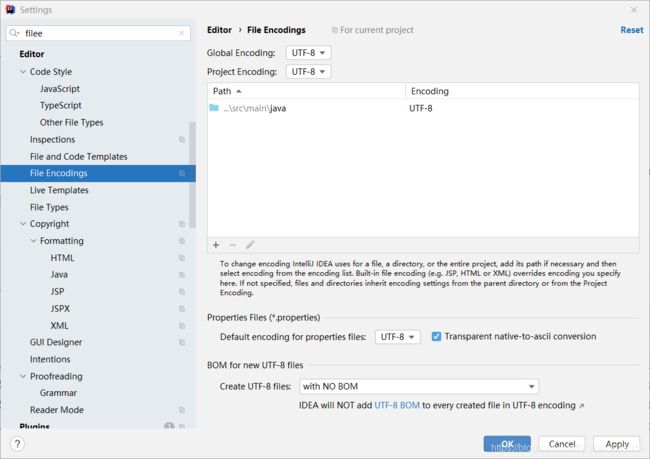
编写国际化配置文件,抽取页面需要显示的国际化页面消息。我们可以去登录页面查看一下,哪些内容我们需要编写国际化的配置!
2. 编写 i18n 国际化资源文件
其中新建三个配置文件,用来配置语言:
-
login.properties:无语言配置时候生效
-
login_en_US.properties:英文生效
-
login_zh_CN.properties:中文生效
命名方式是下划线的组合:文件名_语言_国家.properties;
以此方式命名,IDEA会帮我们识别这是个国际化配置包,自动绑定在一起转换成如下的模式:
此时我们发现 IDEA自动识别了我们要做国际化操作;文件夹变了!
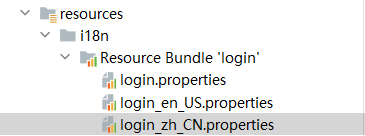
绑定在一起后,我们想要添加更过语言配置,只需要在大的资源包右键添加到该绑定配置文件即可

此时只需要输入区域名即可创建成功,比如输入en_US,就会自动识别
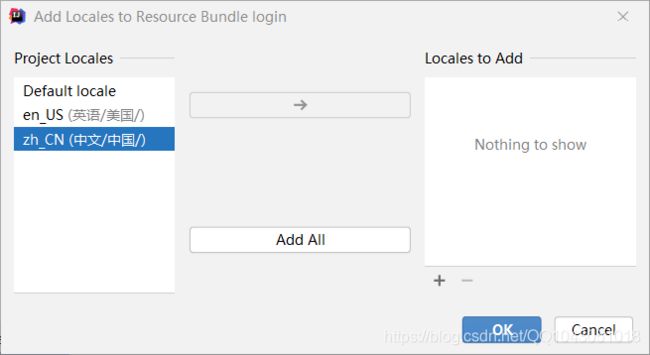
然后打开英文或者中文语言的配置文件,点击Resource Bundle进入可视化编辑页面
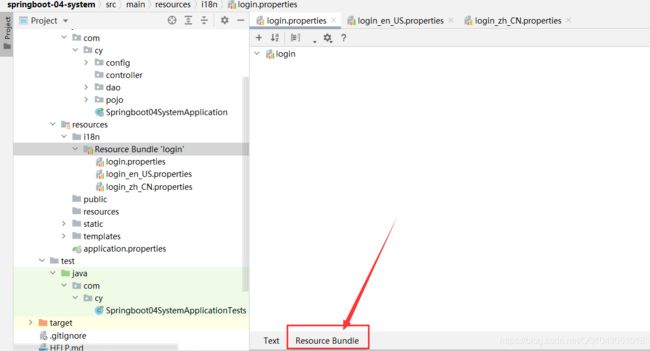
进入到可视化编辑页面后,点击加号,添加属性,首先新建一个login.tip代表首页中的提示
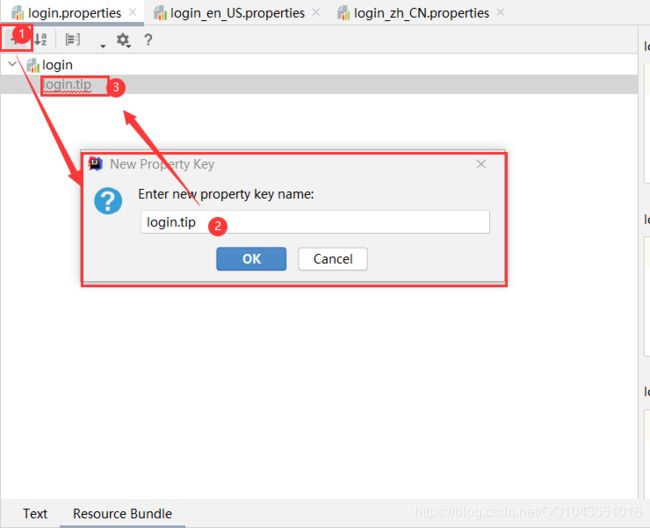
然后对该提示分别做三种情况的语言配置,在三个对应的输入框输入即可(注意:IDEA2020.1可能无法保存,建议直接在配置文件中编写)
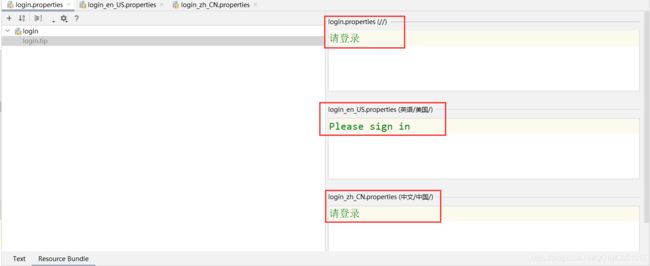
双击点来login.tip 我们可以发现 我们可视化的方便,一次性就可以配置3种



接下来再配置所有要转换语言的变量(注意:IDEA2020.1可能无法保存,建议直接在配置文件中编写)
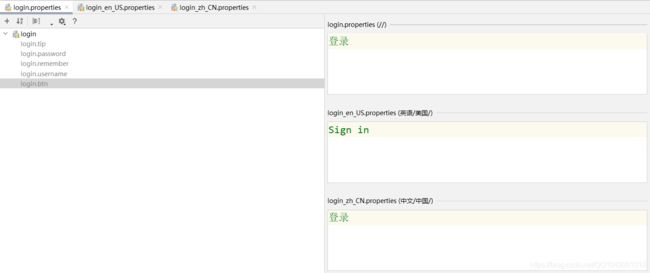
然后打开三个配置文件的检查 查看其中的文本内容,可以看到已经做好了全部的配置
login.properties
login.btn=登录
login.password=密码
login.remember=记住我
login.tip=请登录
login.username=用户名
login_en_US.properties
login.btn=Sign in
login.password=Password
login.remember=Remember me
login.tip=Please sign in
login.username=username
login_zh_CN.properties
login.btn=登录
login.password=密码
login.remember=记住我
login.tip=请登录
login.username=用户名
3. 配置国际化资源文件名称
在Spring程序中,国际化主要是通过 ResourceBundleMessageSource 这个类来实现的
Spring Boot通过 MessageSourceAutoConfiguration 为我们自动配置好了管理国际化资源文件的组件
我们在IDEA中查看以下MessageSourceAutoConfiguration类
@Configuration(proxyBeanMethods = false)
@ConditionalOnMissingBean(name = AbstractApplicationContext.MESSAGE_SOURCE_BEAN_NAME, search = SearchStrategy.CURRENT)
@AutoConfigureOrder(Ordered.HIGHEST_PRECEDENCE)
@Conditional(ResourceBundleCondition.class)
@EnableConfigurationProperties
public class MessageSourceAutoConfiguration {
private static final Resource[] NO_RESOURCES = {};
@Bean
@ConfigurationProperties(prefix = "spring.messages")
public MessageSourceProperties messageSourceProperties() {
return new MessageSourceProperties();
}
@Bean
public MessageSource messageSource(MessageSourceProperties properties) {
ResourceBundleMessageSource messageSource = new ResourceBundleMessageSource();
if (StringUtils.hasText(properties.getBasename())) {
//他可以设置我们Basenames 基本的名字
messageSource.setBasenames(StringUtils
//然后他会从properties.getBasename(),我们的配置文件去找
.commaDelimitedListToStringArray(StringUtils.trimAllWhitespace(properties.getBasename())));
}
if (properties.getEncoding() != null) {
messageSource.setDefaultEncoding(properties.getEncoding().name());
}
messageSource.setFallbackToSystemLocale(properties.isFallbackToSystemLocale());
Duration cacheDuration = properties.getCacheDuration();
if (cacheDuration != null) {
messageSource.setCacheMillis(cacheDuration.toMillis());
}
messageSource.setAlwaysUseMessageFormat(properties.isAlwaysUseMessageFormat());
messageSource.setUseCodeAsDefaultMessage(properties.isUseCodeAsDefaultMessage());
return messageSource;
}
//......
}
主要了解messageSource()这个方法:
public MessageSource messageSource(MessageSourceProperties properties);
可以看到,它的参数为MessageSourceProperties对象,我们看看这个类
public class MessageSourceProperties {
/**
* Comma-separated list of basenames (essentially a fully-qualified classpath
* location), each following the ResourceBundle convention with relaxed support for
* slash based locations. If it doesn't contain a package qualifier (such as
* "org.mypackage"), it will be resolved from the classpath root.
*/
private String basename = "messages";
/**
* Message bundles encoding.
*/
private Charset encoding = StandardCharsets.UTF_8;
类中首先声明了一个属性basename,默认值为messages;
我们翻译其注释:
/**
* Comma-separated list of basenames (essentially a fully-qualified classpath
* location), each following the ResourceBundle convention with relaxed support for
* slash based locations. If it doesn't contain a package qualifier (such as
* "org.mypackage"), it will be resolved from the classpath root.
*/
-
逗号分隔的基名列表(本质上是完全限定的类路径位置)
-
每个都遵循ResourceBundle约定,并轻松支持于斜杠的位置
-
如果不包含包限定符(例如"org.mypackage"),它将从类路径根目录中解析
意思是:
-
如果你不在springboot配置文件中指定以.分隔开的国际化资源文件名称的话
-
它默认会去类路径下找messages.properties作为国际化资源文件
这里我们自定义了国际化资源文件,因此我们需要在SpringBoot配置文件application.properties中加入以下配置指定我们配置文件的名称
# 我们的配置文件的真实位置
spring.messages.basename=i18n.login
其中i18n是存放资源的文件夹名,login是资源文件的基本名称。
4.首页获取显示国际化值
去页面获取国际化的值,查看Thymeleaf的文档,找到message取值操作为:#{…}。
IDEA还有提示,非常智能的!
利用#{…} 消息表达式,去首页index.html获取国际化的值,没在<>内的,使用#[[#{ }]]
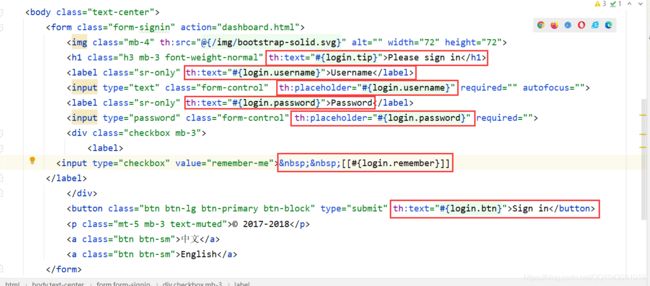
<html lang="en" xmlns:th="http://www.thymeleaf.org">
<head>
<meta http-equiv="Content-Type" content="text/html; charset=UTF-8">
<meta name="viewport" content="width=device-width, initial-scale=1, shrink-to-fit=no">
<meta name="description" content="">
<meta name="author" content="">
<title>登录首页title>
<link th:href="@{/css/bootstrap.min.css}" rel="stylesheet">
<link th:href="@{/css/signin.css}" rel="stylesheet">
head>
<body class="text-center">
<form class="form-signin" action="dashboard.html">
<img class="mb-4" th:src="@{/img/bootstrap-solid.svg}" alt="" width="72" height="72">
<h1 class="h3 mb-3 font-weight-normal" th:text="#{login.tip}">Please sign inh1>
<label class="sr-only">Usernamelabel>
<input type="text" class="form-control" th:text="#{login.username}" placeholder="Username..." required="" autofocus="">
<label class="sr-only">Passwordlabel>
<input type="password" class="form-control" th:text="#{login.password}" placeholder="Password..." required="">
<div class="checkbox mb-3">
<label>
<input type="checkbox" value="remember-me" th:text="#{login.remember}"> Remeember me
label>
div>
<button class="btn btn-lg btn-primary btn-block" type="submit" th:text="#{login.btn}">Sign inbutton>
<p class="mt-5 mb-3 text-muted">© 2020-2021p>
<a class="btn btn-sm">中文a>
<a class="btn btn-sm">Englisha>
form>
body>
html>
重启项目,访问首页,发现已经自动识别为中文的了!
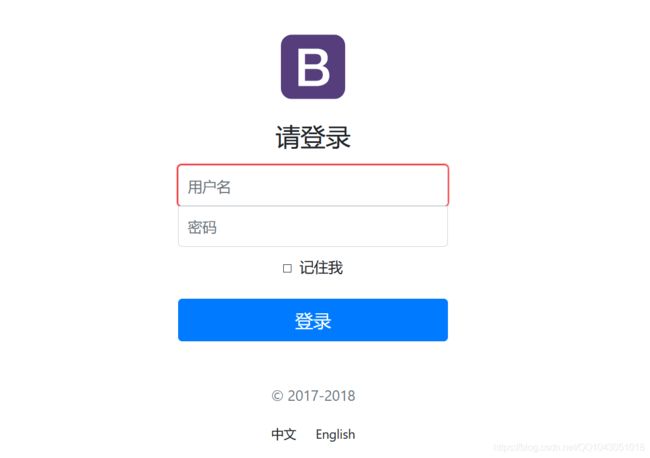
但是我们想要更好!可以根据按钮自动切换中文英文!
5. 配置国际化组件实现中英文切换
思考:
html lang="en"或html lang="en-US"分别代表什么
HTML的lang属性是用来声明语言类型,,
, , ,
, , 以及
<html lang="en">html>//英文
<html lang="zh-CN">html>//中文
<html lang="ja">html>//日文
<html lang="en-US">html>//美式英文
<div lang="en">this is English .div>//英文
写在html标签中的lang属性是声明当前页面的语言类型,这些对于搜索引擎、网页翻译、屏幕阅读浏览器有指导意义。
1.添加中英文切换标签链接
上述实现了登录首页显示为中文,我们在index.html页面中可以看到两个标签
<a class="btn btn-sm">中文a>
<a class="btn btn-sm">Englisha>
也就对应着视图中的

那么我们怎么通过这两个标签实现中英文切换呢?
首先在这两个标签上加上跳转链接并带上相应的参数
<a class="btn btn-sm" th:href="@{/index.html(l='zh_CN')}">中文a>
<a class="btn btn-sm" th:href="@{/index.html(l='en_US')}">Englisha>
2.自定义地区解析器组件
怎么实现我们自定义的地区解析器呢?我们首先来分析一波源码
在Spring中有关于国际化的两个类:
- Locale:代表地区,每一个
Locale对象都代表了一个特定的地理、政治和文化地区 - LocaleResolver:地区解析器
首先搜索WebMvcAutoConfiguration,可以在其中找到关于一个方法localeResolver()
@Bean
@ConditionalOnMissingBean
@ConditionalOnProperty(prefix = "spring.mvc", name = "locale")
public LocaleResolver localeResolver() {
//如果用户配置了,则使用用户配置好的
if (this.mvcProperties.getLocaleResolver() == WebMvcProperties.LocaleResolver.FIXED) {
return new FixedLocaleResolver(this.mvcProperties.getLocale());
}
//用户没有配置,则使用默认的
AcceptHeaderLocaleResolver localeResolver = new AcceptHeaderLocaleResolver();
localeResolver.setDefaultLocale(this.mvcProperties.getLocale());
return localeResolver;
}
该方法就是获取LocaleResolver地区对象解析器:
- 如果用户配置了则使用用户配置的地区解析器;
- 如果用户没有配置,则使用默认的地区解析器
我们可以看到默认地区解析器的是AcceptHeaderLocaleResolver对象,我们点入该类查看源码

可以发现它继承了LocaleResolver接口,实现了地区解析
因此我们想要实现上述自定义的国际化资源生效,只需要编写一个自己的地区解析器,继承LocaleResolver接口,重写其方法即可。
我们在config包下新建MyLocaleResolver,作为自己的国际化地区解析器
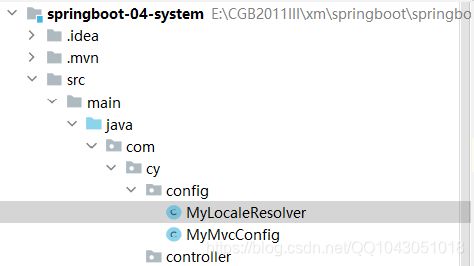
我们在index.html中,编写了对应的请求跳转
-
如果点击中文按钮,则跳转到/index.html(l=‘zh_CN’)页面
-
如果点击English按钮,则跳转到/index.html(l=‘en_US’)页面
<a class="btn btn-sm" th:href="@{/index.html(l='zh_CN')}">中文</a>
<a class="btn btn-sm" th:href="@{/index.html(l='en_US')}">English</a>
因此我们自定义的地区解析器MyLocaleResolver中,需要处理这两个带参数的链接请求
package com.cy.config;
import org.springframework.web.servlet.LocaleResolver;
import org.thymeleaf.util.StringUtils;
import javax.servlet.http.HttpServletRequest;
import javax.servlet.http.HttpServletResponse;
import java.util.Locale;
public class MyLocaleResolver implements LocaleResolver {
//解析请求
@Override
public Locale resolveLocale(HttpServletRequest request) {
//获取请求中的国际化参数
String language = request.getParameter("l");
//默认的地区
Locale locale = Locale.getDefault();
//如果请求的链接参数不为空,携带了国际化参数
if (!StringUtils.isEmpty(language)){
//split分隔
String[] split = language.split("_");
//zh_CN(语言_地区)
locale = new Locale(split[0], split[1]);
}
return locale;
}
@Override
public void setLocale(HttpServletRequest httpServletRequest, HttpServletResponse httpServletResponse, Locale locale) {
}
}
为了让我们的区域化信息能够生效,我们需要再配置一下这个组件!在自己的MvcConofig配置类下添加bean;
//自定义的国际化组件生效
@Bean
public LocaleResolver localeResolver() {
return new MyLocaleResolver();
}
我们重启项目,来访问一下,发现点击按钮可以实现成功切换!
点击中文按钮,跳转到http://localhost:8080/index.html?l=zh_CN,显示为中文
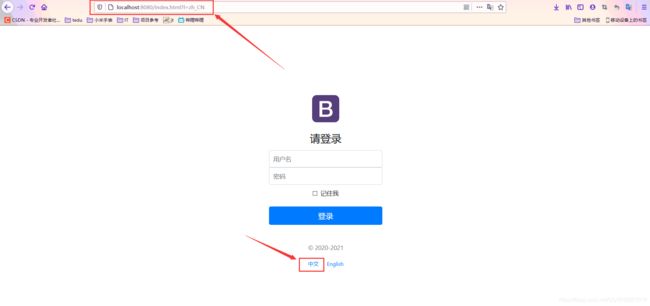
点击English按钮,跳转到http://localhost:8080/index.html?l=en_US,显示为英文:
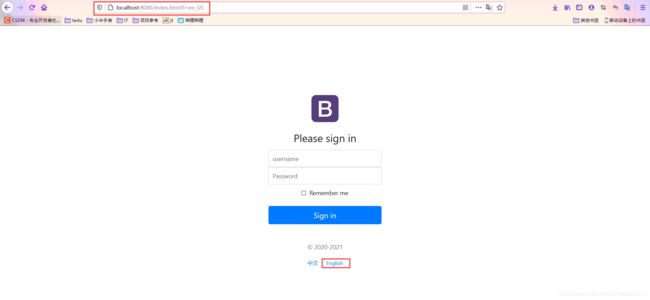
【注意点】:
首页配置:
- 注意点,所有页面的静态资源都需要使用thymeleaf模板引擎接管
- url:@{}
页面国际化:
- 我们需要配置i18n文件
- 我们如果需要在项目中进行按钮自动切换,我们需要自定义一个组件LocaleResolver
- 记得将自己写的组件配置到 spring容器
@Bean - #{}
四、登录功能的实现
登录,也就是当我们点击登录按钮的时候,会进入一个页面,这里进入dashboard页面
因此我们首先在index.html中的表单编写一个提交地址/user/login,并给名称和密码输入框添加name属性为了后面的传参

1.编写对应的controller
在主程序同级目录下新建controller包,在其中新建类loginController,处理登录请求
package com.cy.controller;
import org.springframework.stereotype.Controller;
import org.springframework.ui.Model;
import org.springframework.web.bind.annotation.RequestMapping;
import org.springframework.web.bind.annotation.RequestParam;
import org.thymeleaf.util.StringUtils;
@Controller
public class LoginController {
@RequestMapping("/user/login")
//@RequestParam请求参数
public String login(@RequestParam("username") String username,
@RequestParam("password") String password,
Model model){
//具体的业务
//账号密码正确,就登录成功
if("admin".equals(username) && "123456".equals(password)){
return "dashboard";//跳转到dashboard页面
//如果用户名或者密码不正确
}else{
model.addAttribute("msg", "用户名或者密码错误!");//显示错误信息
return "index";//跳转回首页
}
}
}
然后我们在index.html首页中加一个标签用来显示controller返回的错误信息
<p style="color: red" th:text="${msg}" th:if="${not #strings.isEmpty(msg)}">p>
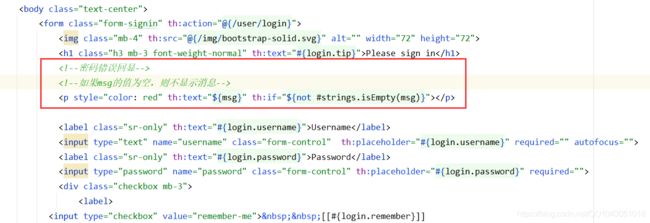
我们再测试一下,启动主程序,访问localhost:8080
则重新跳转到dashboard页面,浏览器url为http://localhost:8080/user/login?username=admin&password=123456
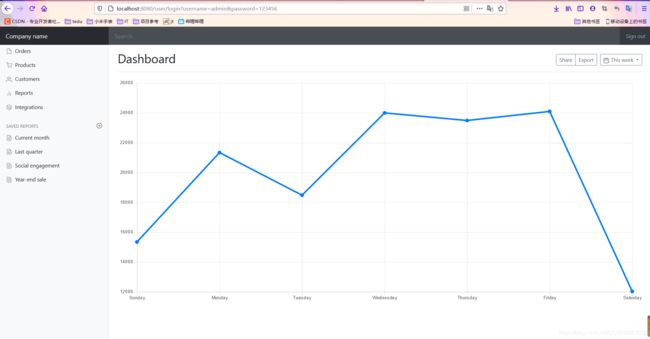
随便输入错误的用户名123,输入错误的密码123456
浏览器url为http://localhost:8080/user/login?username=123&password=123456,页面上附有错误提示信息
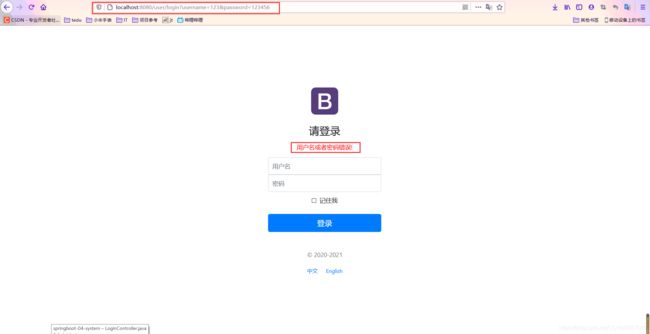
到此我们的登录功能实现完毕,但是有一个很大的问题,浏览器的url暴露了用户的用户名和密码,这在实际开发中可是重大的漏洞,泄露了用户信息,因此我们需要编写一个映射!
2.添加映射
我们在自定义的配置类 MyMvcConfig 映射资源中加一句代码
registry.addViewController("/main.html").setViewName("dashboard");
也就是访问/main.html页面就跳转到dashboard页面
然后我们稍稍修改一下LoginController,当登录成功时重定向到main.html页面,也就跳转到了dashboard页面
@Controller
public class LoginController {
@RequestMapping("/user/login")
//@RequestParam请求参数
public String login(@RequestParam("username") String username,
@RequestParam("password") String password,
Model model){
//具体的业务
//如果用户名和密码不为空,账号密码正确,就登录成功
if(!StringUtils.isEmpty(username) && "admin".equals(username) && "123456".equals(password)){
return "redirect:/main.html";//重定向到main.html页面,也就是跳转到dashboard页面
//如果用户名或者密码不正确
}else{
model.addAttribute("msg", "用户名或者密码错误!");//显示错误信息
return "index";//跳转回首页
}
}
}
我们再次重启测试,输入正确的用户名和密码登陆成功后,浏览器不再携带泄露信息
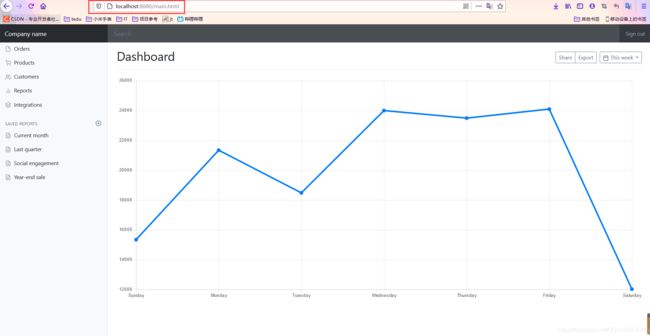
但是这又出现了新的问题,无论登不登陆,我们访问localhost/main.html都会跳转到dashboard的页面,这就引入了接下来的拦截器!
五、登录拦截器
为了解决上述遗留的问题,我们需要自定义一个拦截器;
在config目录下,新建一个登录拦截器类LoginHandlerInterceptor
用户登录成功后,后台会得到用户信息;如果没有登录,则不会有任何的用户信息;
我们就可以利用这一点通过拦截器进行拦截:
- 当用户登录时将用户信息存入session中,访问页面时首先判断session中有没有用户的信息
- 如果没有,拦截器进行拦截;
- 如果有,拦截器放行
1.配置拦截器
因此我们首先在LoginController中当用户登录成功后,存入用户信息到session中
@Controller
public class LoginController {
@RequestMapping("/user/login")
//@RequestParam请求参数
public String login(@RequestParam("username") String username,
@RequestParam("password") String password,
Model model, HttpSession session){
//具体的业务
//如果用户名和密码不为空,账号密码正确,就登录成功
if("admin".equals(username) && "123456".equals(password)){
session.setAttribute("loginUser", username);
return "redirect:/main.html";//重定向到main.html页面,也就是跳转到dashboard页面
//如果用户名或者密码不正确
}else{
model.addAttribute("msg", "用户名或者密码错误!");//显示错误信息
return "index";//跳转回首页
}
}
}
然后再在实现自定义的登录拦截器,继承HandlerInterceptor接口
-
其中获取存入的session进行判断,如果不为空,则放行;
-
如果为空,则返回错误消息,并且返回到首页,不放行。
package com.cy.config;
import org.springframework.web.servlet.HandlerInterceptor;
import javax.servlet.http.HttpServletRequest;
import javax.servlet.http.HttpServletResponse;
public class LoginHandlerInterceptor implements HandlerInterceptor {
@Override
public boolean preHandle(HttpServletRequest request, HttpServletResponse response, Object handler) throws Exception {
//用户登录成功后,应该有自己的session
Object session = request.getSession().getAttribute("LoginUser");
if (session == null) {//没有登录
request.setAttribute("msg", "权限不够,请先登录");
request.getRequestDispatcher("/index.html").forward(request, response);
return false;
} else {
return true;
}
}
}
然后配置到bean中注册,在MyMvcConfig配置类中,重写关于拦截器的方法,添加我们自定义的拦截器,注意屏蔽静态资源及主页以及相关请求的拦截
@Override
public void addInterceptors(InterceptorRegistry registry) {
//添加拦截器
registry.addInterceptor(new LoginHandlerInterceptor())
//拦截所有请求
.addPathPatterns("/**")
//排除一些请求
.excludePathPatterns("/index.html", "/", "/user/login", "/css/**", "/js/**", "/img/**");
}
2.测试
然后重启主程序进行测试,直接访问http://localhost:8080/main.html

提示权限不够,被拦截了,请先登录,我们登录一下,进入到dashboard页面
如果我们再直接重新访问http://localhost:8080/main.html,也可以直接直接进入到dashboard页面,这是因为session里面存入了用户的信息,拦截器放行通过
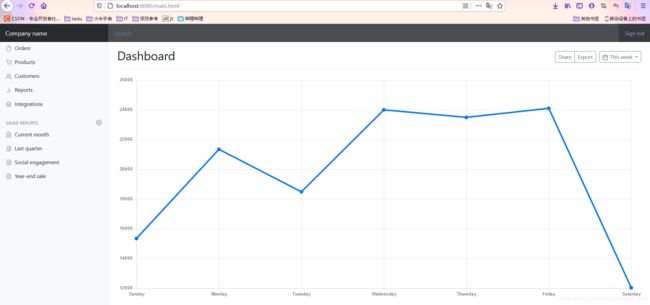
接下来我们给Company name也设置成自动获取
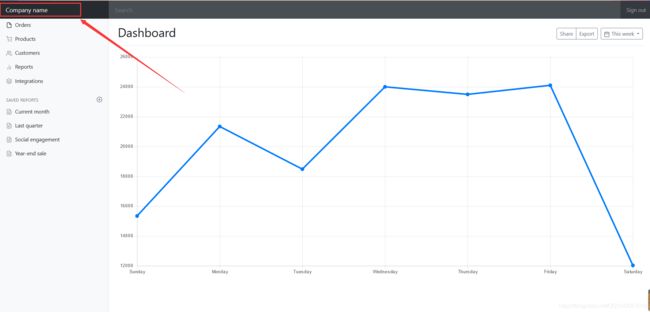
<a class="navbar-brand col-sm-3 col-md-2 mr-0" href="http://getbootstrap.com/docs/4.0/examples/dashboard/#">[[${session.LoginUser}]]</a>
六、展示员工信息
1.实现Customers视图跳转
目标:点击dashboard.html页面中的Customers展示跳转到list.html页面显示所有员工信息,我这里把标签都改成了中文,可改可不改。
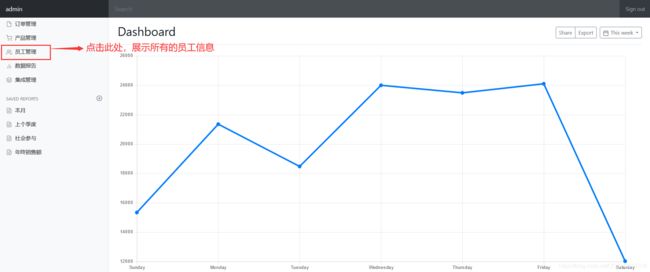
因此,我们首先给dashboard.html页面中Customers部分标签添加href属性,实现点击该标签请求/emps路径跳转到list.html展示所有的员工信息
同样修改list.html对应该的代码为上述代码

我们在templates目录下新建一个包emp,用来放所有关于员工信息的页面,我们将list.html页面移入该包中
然后编写请求对应的controller,处理/emps请求,在controller包下,新建一个EmployeeController类
@Controller
public class EmployeeController {
@Autowired
private EmployeeDao employeeDao;
@RequestMapping("/emps")
public String list(Model model) {
Collection<Employee> employees = employeeDao.getAll();
model.addAttribute("emps",employees);
return "emp/list";//返回到list页面
}
}
然后我们重启主程序进行测试,登录到dashboard页面,再点击Customers,成功跳转到/emps
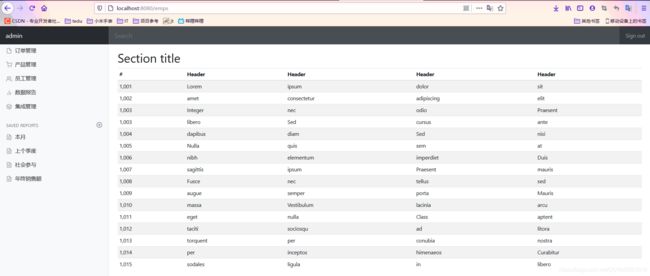
但是有些问题:
- 我们点击了
Customers后,它应该处于高亮状态,但是这里点击后还是普通的样子,高亮还是在Dashboard上 list.html和dashboard.html页面的侧边栏和顶部栏是相同的,可以抽取出来
2. 提取页面公共部分
在templates目录下新建一个commons包,其中新建commons.html用来放置公共页面代码
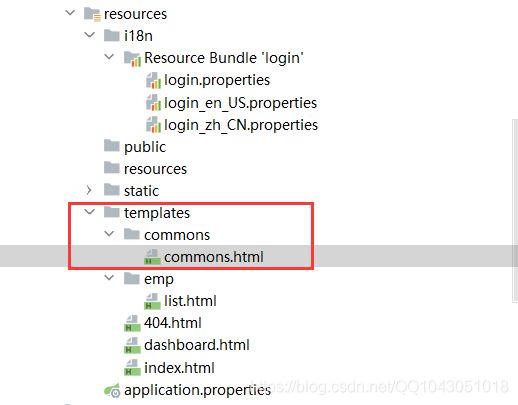
利用th:fragment标签抽取公共部分(顶部导航栏和侧边栏)
<!DOCTYPE html>
<html lang="en" xmlns:th="http://www.thymeleaf.org">
<!--顶部导航栏,利用th:fragment提取出来,命名为topbar-->
<nav class="navbar navbar-dark sticky-top bg-dark flex-md-nowrap p-0" th:fragment="topbar">
<a class="navbar-brand col-sm-3 col-md-2 mr-0" href="http://getbootstrap.com/docs/4.0/examples/dashboard/#">[[${session.LoginUser}]]</a>
<input class="form-control form-control-dark w-100" type="text" placeholder="Search" aria-label="Search">
<ul class="navbar-nav px-3">
<li class="nav-item text-nowrap">
<a class="nav-link" href="http://getbootstrap.com/docs/4.0/examples/dashboard/#">Sign out</a>
</li>
</ul>
</nav>
<!--侧边栏,利用th:fragment提取出来,命名为sidebar-->
<nav class="col-md-2 d-none d-md-block bg-light sidebar" th:fragment="siderbar">
<div class="sidebar-sticky">
<ul class="nav flex-column">
<li class="nav-item">
<a class="nav-link active" href="http://getbootstrap.com/docs/4.0/examples/dashboard/#">
<svg xmlns="http://www.w3.org/2000/svg" width="24" height="24" viewBox="0 0 24 24" fill="none" stroke="currentColor" stroke-width="2" stroke-linecap="round" stroke-linejoin="round" class="feather feather-home">
<path d="M3 9l9-7 9 7v11a2 2 0 0 1-2 2H5a2 2 0 0 1-2-2z"></path>
<polyline points="9 22 9 12 15 12 15 22"></polyline>
</svg>
Dashboard <span class="sr-only">(current)</span>
</a>
</li>
<li class="nav-item">
<a class="nav-link" href="http://getbootstrap.com/docs/4.0/examples/dashboard/#">
<svg xmlns="http://www.w3.org/2000/svg" width="24" height="24" viewBox="0 0 24 24" fill="none" stroke="currentColor" stroke-width="2" stroke-linecap="round" stroke-linejoin="round" class="feather feather-file">
<path d="M13 2H6a2 2 0 0 0-2 2v16a2 2 0 0 0 2 2h12a2 2 0 0 0 2-2V9z"></path>
<polyline points="13 2 13 9 20 9"></polyline>
</svg>
订单管理
</a>
</li>
<li class="nav-item">
<a class="nav-link" href="http://getbootstrap.com/docs/4.0/examples/dashboard/#">
<svg xmlns="http://www.w3.org/2000/svg" width="24" height="24" viewBox="0 0 24 24" fill="none" stroke="currentColor" stroke-width="2" stroke-linecap="round" stroke-linejoin="round" class="feather feather-shopping-cart">
<circle cx="9" cy="21" r="1"></circle>
<circle cx="20" cy="21" r="1"></circle>
<path d="M1 1h4l2.68 13.39a2 2 0 0 0 2 1.61h9.72a2 2 0 0 0 2-1.61L23 6H6"></path>
</svg>
产品管理
</a>
</li>
<li class="nav-item">
<a class="nav-link" th:href="@{/emps}">
<svg xmlns="http://www.w3.org/2000/svg" width="24" height="24" viewBox="0 0 24 24" fill="none" stroke="currentColor" stroke-width="2" stroke-linecap="round" stroke-linejoin="round" class="feather feather-users">
<path d="M17 21v-2a4 4 0 0 0-4-4H5a4 4 0 0 0-4 4v2"></path>
<circle cx="9" cy="7" r="4"></circle>
<path d="M23 21v-2a4 4 0 0 0-3-3.87"></path>
<path d="M16 3.13a4 4 0 0 1 0 7.75"></path>
</svg>
员工管理
</a>
</li>
<li class="nav-item">
<a class="nav-link" href="http://getbootstrap.com/docs/4.0/examples/dashboard/#">
<svg xmlns="http://www.w3.org/2000/svg" width="24" height="24" viewBox="0 0 24 24" fill="none" stroke="currentColor" stroke-width="2" stroke-linecap="round" stroke-linejoin="round" class="feather feather-bar-chart-2">
<line x1="18" y1="20" x2="18" y2="10"></line>
<line x1="12" y1="20" x2="12" y2="4"></line>
<line x1="6" y1="20" x2="6" y2="14"></line>
</svg>
数据报告
</a>
</li>
<li class="nav-item">
<a class="nav-link" href="http://getbootstrap.com/docs/4.0/examples/dashboard/#">
<svg xmlns="http://www.w3.org/2000/svg" width="24" height="24" viewBox="0 0 24 24" fill="none" stroke="currentColor" stroke-width="2" stroke-linecap="round" stroke-linejoin="round" class="feather feather-layers">
<polygon points="12 2 2 7 12 12 22 7 12 2"></polygon>
<polyline points="2 17 12 22 22 17"></polyline>
<polyline points="2 12 12 17 22 12"></polyline>
</svg>
集成管理
</a>
</li>
</ul>
<h6 class="sidebar-heading d-flex justify-content-between align-items-center px-3 mt-4 mb-1 text-muted">
<span>Saved reports</span>
<a class="d-flex align-items-center text-muted" href="http://getbootstrap.com/docs/4.0/examples/dashboard/#">
<svg xmlns="http://www.w3.org/2000/svg" width="24" height="24" viewBox="0 0 24 24" fill="none" stroke="currentColor" stroke-width="2" stroke-linecap="round" stroke-linejoin="round" class="feather feather-plus-circle"><circle cx="12" cy="12" r="10"></circle><line x1="12" y1="8" x2="12" y2="16"></line><line x1="8" y1="12" x2="16" y2="12"></line></svg>
</a>
</h6>
<ul class="nav flex-column mb-2">
<li class="nav-item">
<a class="nav-link" href="http://getbootstrap.com/docs/4.0/examples/dashboard/#">
<svg xmlns="http://www.w3.org/2000/svg" width="24" height="24" viewBox="0 0 24 24" fill="none" stroke="currentColor" stroke-width="2" stroke-linecap="round" stroke-linejoin="round" class="feather feather-file-text">
<path d="M14 2H6a2 2 0 0 0-2 2v16a2 2 0 0 0 2 2h12a2 2 0 0 0 2-2V8z"></path>
<polyline points="14 2 14 8 20 8"></polyline>
<line x1="16" y1="13" x2="8" y2="13"></line>
<line x1="16" y1="17" x2="8" y2="17"></line>
<polyline points="10 9 9 9 8 9"></polyline>
</svg>
本月
</a>
</li>
<li class="nav-item">
<a class="nav-link" href="http://getbootstrap.com/docs/4.0/examples/dashboard/#">
<svg xmlns="http://www.w3.org/2000/svg" width="24" height="24" viewBox="0 0 24 24" fill="none" stroke="currentColor" stroke-width="2" stroke-linecap="round" stroke-linejoin="round" class="feather feather-file-text">
<path d="M14 2H6a2 2 0 0 0-2 2v16a2 2 0 0 0 2 2h12a2 2 0 0 0 2-2V8z"></path>
<polyline points="14 2 14 8 20 8"></polyline>
<line x1="16" y1="13" x2="8" y2="13"></line>
<line x1="16" y1="17" x2="8" y2="17"></line>
<polyline points="10 9 9 9 8 9"></polyline>
</svg>
上个季度
</a>
</li>
<li class="nav-item">
<a class="nav-link" href="http://getbootstrap.com/docs/4.0/examples/dashboard/#">
<svg xmlns="http://www.w3.org/2000/svg" width="24" height="24" viewBox="0 0 24 24" fill="none" stroke="currentColor" stroke-width="2" stroke-linecap="round" stroke-linejoin="round" class="feather feather-file-text">
<path d="M14 2H6a2 2 0 0 0-2 2v16a2 2 0 0 0 2 2h12a2 2 0 0 0 2-2V8z"></path>
<polyline points="14 2 14 8 20 8"></polyline>
<line x1="16" y1="13" x2="8" y2="13"></line>
<line x1="16" y1="17" x2="8" y2="17"></line>
<polyline points="10 9 9 9 8 9"></polyline>
</svg>
社会参与
</a>
</li>
<li class="nav-item">
<a class="nav-link" href="http://getbootstrap.com/docs/4.0/examples/dashboard/#">
<svg xmlns="http://www.w3.org/2000/svg" width="24" height="24" viewBox="0 0 24 24" fill="none" stroke="currentColor" stroke-width="2" stroke-linecap="round" stroke-linejoin="round" class="feather feather-file-text">
<path d="M14 2H6a2 2 0 0 0-2 2v16a2 2 0 0 0 2 2h12a2 2 0 0 0 2-2V8z"></path>
<polyline points="14 2 14 8 20 8"></polyline>
<line x1="16" y1="13" x2="8" y2="13"></line>
<line x1="16" y1="17" x2="8" y2="17"></line>
<polyline points="10 9 9 9 8 9"></polyline>
</svg>
年终销售额
</a>
</li>
</ul>
</div>
</nav>
</html>
然后删除dashboard.html和list.html中顶部导航栏和侧边栏的代码
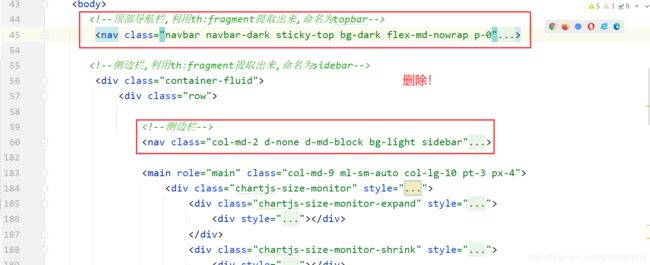
我们再次重启主程序测试一下,登陆成功后,可以看到已经没有了顶部导航栏和侧边栏
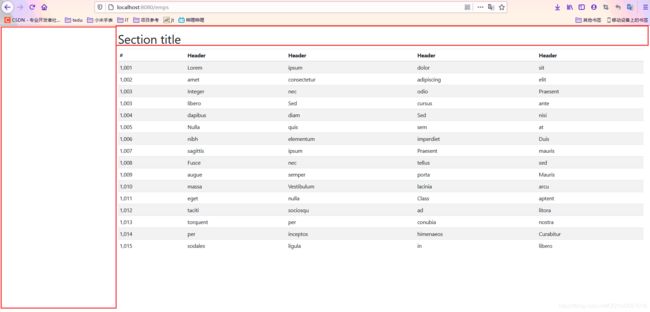
这是因为我们删除了公共部分,还没有引入,我们分别在dashboard.html和list.html删除的部分插入提取出来的公共部分topbar和sidebar
<div th:replace="~{commons/commons::topbar}" }>div>
<div th:replace="~{commons/commons::siderbar}">div>
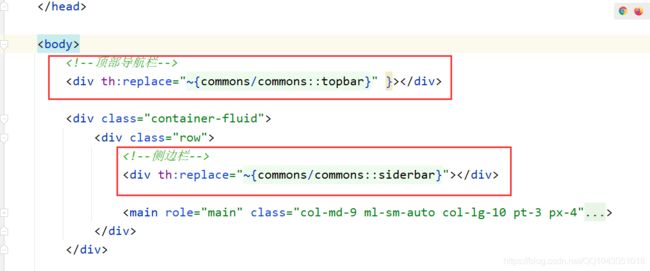
再次重启主程序进行测试,登陆成功后,成功看到侧边栏和顶部栏,代表我们插入成功
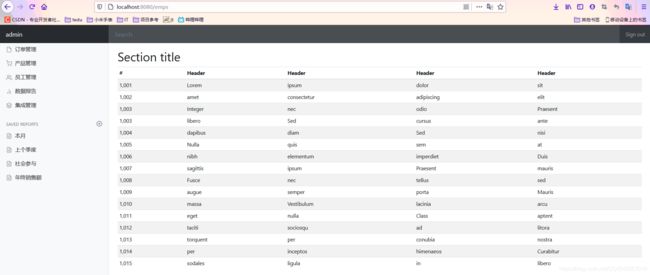
3. 点击高亮处理
在页面中,使高亮的代码是class="nav-link active"属性

我们可以传递参数判断点击了哪个标签实现相应的高亮
首先在dashboard.html的侧边栏标签传递参数active为dashboard.html
<div th:replace="~{commons/commons::siderbar(active='dashboard.html')}">div>

同样在list.html的侧边栏标签传递参数active为list.html
<div th:replace="~{commons/commons::siderbar(active='list.html')}">div>
然后我们在公共页面commons.html相应标签部分利用thymeleaf接收参数active,利用三元运算符判断决定是否高亮
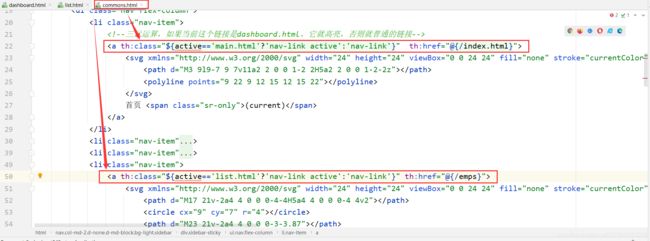
再次重启主程序测试,,点击员工管理,员工管理高亮,成功
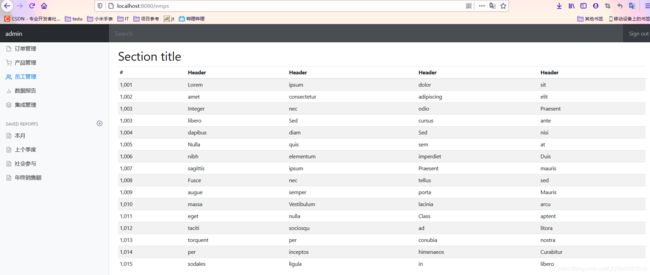
4. 显示员工信息
修改完成后,重启主程序,登录完成后查看所有员工信息,成功显示

接下来修改一下性别的显示和date的显示,并添加编辑和删除两个标签,为后续做准备
<thead>
<tr>
<th>idth>
<th>lastNameth>
<th>emailth>
<th>genderth>
<th>departmentth>
<th>birthth>
<th>操作th>
tr>
thead>
<tbody>
<tr th:each="emp:${emps}">
<td th:text="${emp.getId()}">td>
<td> [[${emp.getLastName()}]]td>
<td th:text="${emp.getEmail()}">td>
<td th:text="${emp.getGender()==0?'女':'男'}">td>
<td th:text="${emp.getDepartment().getDepartmentName()}">td>
<td th:text="${#dates.format(emp.getBirth(),'yyyy-MM-dd HH:mm:ss')}">td>
<td>
<a class="btn btn-sm btn-primary">编辑a>
<a class="btn btn-sm btn-danger" >删除a>
td>
tr>
tbody>
七、增加员工实现
1. list页面增加添加员工按钮
首先在list.html页面增添一个增加员工按钮,点击该按钮时发起一个请求/add
<h2><a class="btn btn-sm btn-success" th:href="@{/emp}">添加员工a>h2>
然后编写对应的controller,处理点击添加员工的请求
这里通过get方式提交请求,在EmployeeController中添加一个方法add用来处理list页面点击提交按钮的操作,返回到add.html添加员工页面,我们即将创建
@Autowired
DepartmentDao departmentDao;
@GetMapping("/emp")
public String add(Model model) {
//查出所有的部门信息,添加到departments中,用于前端接收
Collection<Department> departments = departmentDao.getDepartments();
model.addAttribute("departments", departments);
return "emp/add";//返回到添加员工页面
}
2. 创建添加员工页面add
在templates/emp下新建一个add.html
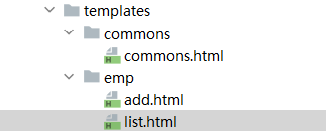
我们复制list.html中的内容,修改其中表格为:
<form>
<div class="form-group">
<label>LastNamelabel>
<input type="text" name="lastName" class="form-control" placeholder="lastname:zsr">
div>
<div class="form-group">
<label>Emaillabel>
<input type="email" name="email" class="form-control" placeholder="email:[email protected]">
div>
<div class="form-group">
<label>Genderlabel><br/>
<div class="form-check form-check-inline">
<input class="form-check-input" type="radio" name="gender" value="1">
<label class="form-check-label">男label>
div>
<div class="form-check form-check-inline">
<input class="form-check-input" type="radio" name="gender" value="0">
<label class="form-check-label">女label>
div>
div>
<div class="form-group">
<label>departmentlabel>
<select class="form-control" name="department.id">
<option th:each="dept:${departments}" th:text="${dept.getDepartmentName()}" th:value="${dept.getId()}">option>
select>
div>
<div class="form-group">
<label>Birthlabel>
<input type="text" name="date" class="form-control" placeholder="birth:yyyy/MM/dd">
div>
<button type="submit" class="btn btn-primary">添加button>
form>
我们重启主程序看看

下拉框中的内容不应该是1、2、3、4、5;应该是所有的部门名,我们遍历得到

<!--其中th:value用来表示部门的id,我们实际传入的值为id-->
<option th:each="department:${departments}" th:text="${department.getDepartmentName()}" th:value="${department.getId()}"></option>
3. add页面添加员工请求
在add.html页面,当我们填写完信息,点击添加按钮,应该完成添加返回到list页面,展示新的员工信息;因此在add.html点击添加按钮的一瞬间,我们同样发起一个请求/emp,与上述提交按钮发出的请求路径一样,但这里发出的是post请求
<form th:action="@{/emp}" method="post">
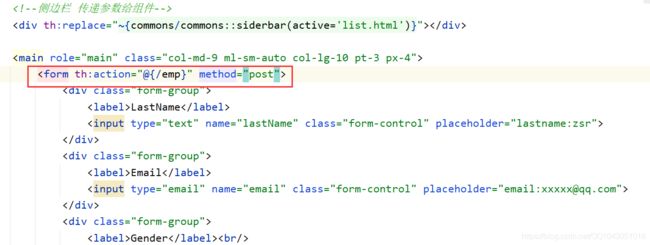
然后编写对应的controller,同样在EmployeeController中添加一个方法addEmp用来处理点击添加按钮的操作
@PostMapping("/emp")
public String addEmp(Employee employee) {
//添加一个员工
employeeDao.addsave(employee);//调用底层业务方法保存员工信息
return "redirect:/emps";//重定向到/emps,刷新列表,返回到list页面
}
我们重启主程序,进行测试,进入添加页面,填写相关信息,注意日期格式默认为yyyy/MM/dd
# 时间日期格式化!
spring.mvc.date-format=yyyy-MM-dd
八、修改员工信息
1. list页面编辑按钮增添请求

当我们点击编辑标签时,应该跳转到编辑页面update.html(我们即将创建)进行编辑
因此首先将list.html页面的编辑标签添加href属性,实现点击请求/emp/id号到编辑页面
<a class="btn btn-sm btn-primary" th:href="@{/emp/{id}(id=${emp.getId()})}">编辑</a>
然后编写对应的controller,在EmployeeController中添加一个方法edit用来处理list页面点击编辑按钮的操作,返回到edit.html编辑员工页面,我们即将创建
//restful风格接收参数
@GetMapping("/emp/{id}")
public String toUpdateEmp(@PathVariable("id") int id, Model model) {
//查出原来的数据
//查询指定id的员工,添加到empByID中,用于前端接收
Employee employee = employeeDao.getEmployeeByID(id);
model.addAttribute("emp", employee);
//查出所有的部门信息,添加到departments中,用于前端接收
Collection<Department> departments = departmentDao.getDepartments();
model.addAttribute("departments", departments);
return "emp/update";//返回到编辑员工页面
}
2. 创建编辑员工页面update
在templates/emp下新建一个update.html
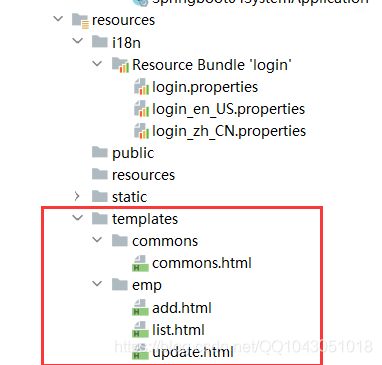
复制add.html中的代码,稍作修改
<main role="main" class="col-md-9 ml-sm-auto col-lg-10 pt-3 px-4">
<form th:action="@{/emp}" method="post">
<div class="form-group">
<label>LastName</label>
<input th:value="${emp.getLastName()}" type="text" name="lastName" class="form-control" placeholder="lastname:zsr">
</div>
<div class="form-group">
<label>Email</label>
<input th:value="${emp.getEmail}" type="email" name="email" class="form-control" placeholder="email:[email protected]">
</div>
<div class="form-group">
<label>Gender</label><br/>
<div class="form-check form-check-inline">
<input th:checked="${emp.getGender()==1}" class="form-check-input" type="radio" name="gender" value="1">
<label class="form-check-label">男</label>
</div>
<div class="form-check form-check-inline">
<input th:checked="${emp.getGender()==0}" class="form-check-input" type="radio" name="gender" value="0">
<label class="form-check-label">女</label>
</div>
</div>
<div class="form-group">
<label>department</label>
<!--注意这里的name是department.id,因为传入的参数为id-->
<!--我们contorller接收的是一个Employee,所以我们需要提交的是其中的一个属性-->
<select class="form-control" name="department.id">
<option th:selected="${dept.getId()==emp.getDepartment}"
th:each="dept:${departments}"
th:text="${dept.getDepartmentName()}"
th:value="${dept.getId()}">
</option>
</select>
</div>
<div class="form-group">
<label>Birth</label>
<input th:value="${emp.getBirth()}" type="text" name="date" class="form-control"
placeholder="birth:yy/MM/dd">
</div>
<button type="submit" class="btn btn-primary">修改</button>
</form>
</main>
</div>
</div>
启动主程序测试,点击编辑1001号用户
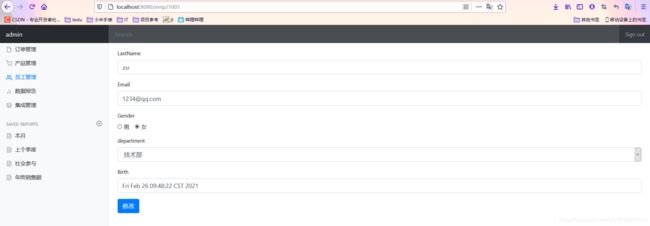
成功跳转到update.html,且所选用户信息正确
但是日期的格式不太正确,我们规定一下显示的日期格式
<!--springboot默认的日期格式为yy/MM/dd-->
<input th:value="${#dates.format(emp.getBirth(),'yyyy/MM/dd HH:mm')}" type="text" name="date" class="form-control" placeholder="birth:yy/MM/dd">
日期修改成功
3. update页面编辑完成提交请求
在update.html点击修改按钮的一瞬间,我们需要返回到list页面,更新员工信息,因此我们需要添加href属性,实现点击按钮时发起一个请求/updateEmp
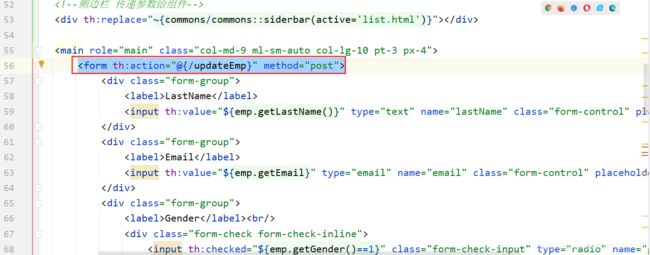
然后编写对应的controller,处理点击修改按钮的请求
同样在EmployeeController中添加一个方法UpdateEmp用来处理update页面点击添加的操作
//提交到后台
@PostMapping("/updateEmp")
public String UpdateEmp(Employee employee) {
employeeDao.addsave(employee);//添加一个员工
return "redirect:/emps";//添加完成重定向到/emps,刷新列表
}
然后指定修改人的id
<input type="hidden" name="id" th:value="${emp.getId()}">
成功修改并返回到list.html
九、删除员工信息

当我们点击删除标签时,应该发起一个请求,删除指定的用户,然后重新返回到list页面显示员工数据
<a class="btn btn-sm btn-danger" th:href="@{/deleteEmp/{id}(id=${emp.getId()})}">删除</a>
然后编写对应的controller,处理点击删除按钮的请求,删除指定员工,重定向到/emps请求,更新员工信息
//删除员工
@GetMapping("/deleteEmp/{id}")
public String deleteEmp(@PathVariable("id") Integer id) {
employeeDao.delete(id);
return "redirect:/emps";
}
重启测试,点击删除按钮即可删除指定员工,我们来删除1005


删除成功
十、404页面定制
只需要在templates目录下新建一个error包,然后将404.html放入其中,报错SpringBoot就会自动找到这个页面


我们可以启动程序测试,随便访问一个不存在的页面

出现的404页面即是我们自己的404.html
十一、注销操作
在我们提取出来的公共commons页面,顶部导航栏处中的标签添加href属性,实现点击发起请求/user/logout
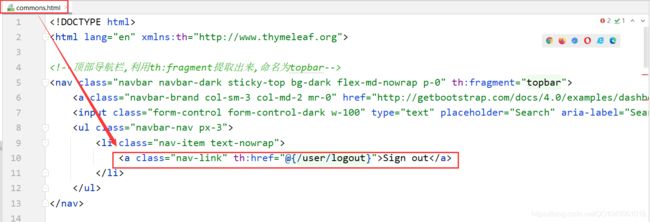
然后编写对应的controller,处理点击注销标签的请求,在LoginController中编写对应的方法,清除session,并重定向到首页
//注销功能
@RequestMapping("/user/logout")
public String logout(HttpSession session) {
session.invalidate();//移除
return "redirect:/index.html";
}
到此,这个项目就基本上完成了,后续也可以自己扩展内容!
扩展:
我们应该如何写一个网站?
后端:作为JAVA开发的程序员,后端我们基本不用太操心
前端:我们的弱势,很难写出来,那么怎么办呢?
使用模板:
正常情况下,我们自己使用模板,拿来改成自己需要的就行了。
- 框架:组件,手动组合拼接(Bootstrap、Layui、semantic-ui)
- 栅格系统
- 导航栏
- 侧边栏
- 表单
步骤:
- 1.前端搞定:页面布局(数据)
- 2.设计数据库(数据库设计难点!)
- 3.前端让他能够自己运行,独立化工程
- 4.数据接口如何对接:JSON,对象all in one
- 5.前后端联调测试!
1.准备一套:自己熟练的后台模板! 推荐:x-admin
2.前端界面:至少自己能够通过前端框架,组合出来一个网站页面
- index
- about
- blog
- post
- user
3.让这个网站能够独立运行!

